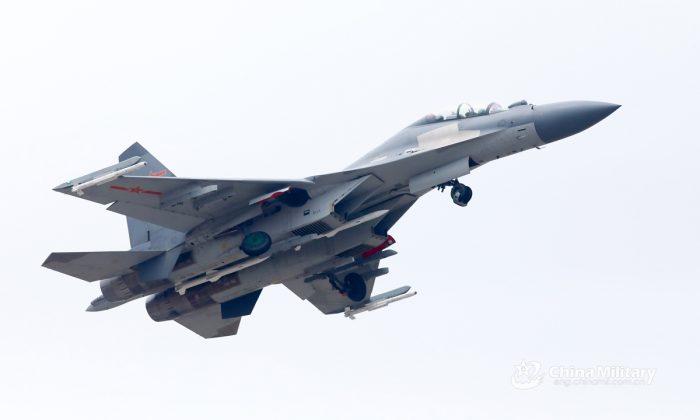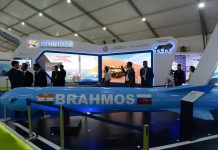A Chinese flying instructor with the PLA recently claimed that the country’s multi-role fighter J-16 is a generation more advanced than the original Russian Su-30 fighter from which it was derived.
He went on to claim that the fighter jet is “flawless and much superior” to even the Su-30, in an interview with a Chinese news channel.
J-16 Fighter Jets
Reports indicate the Shenyang J-16 multirole fighter, which China introduced in 2014, is gaining traction with the PLA and its production has now been stepped up by the country.
While the Indian military experts have always dismissed China’s Flanker derivates and their copies, such as the J-11 fighter, as being inferior to its own Su-30MKIs, the arrival of the J-16 fighters has changed that game.
Armed with the modern multi-mode AESA radar, J-16 is built for both air-to-air and air-to-ground missions unlike J-11 or even Su-27.

The introduction of new datalinks, improved EW systems and increased use of carbon composites by the Chinese on this Su-30 derivate gives it a superior combat capability to even the latest Russian Flanker, the Su-35S.
The J-16 is powered by the indigenously built WS-10 Taihang turbofan engine, which may not be as reliable as the Russian AL-31F engines, but they generate the same amount of thrust.
J-16 incorporates improved technologies as compared to Su-30MKI featuring composite air-frames, Missile Warning System (MAWS), and Radar Warning Receiver (RWR).
That, however, won’t provide the jet any superiority in terms of avionics over the Indian Su-30MKI since it also employs the PESA radar which is equally good with almost the same search and track range.
But that could change if China decided to reverse engineer the Su-35 fighters that the country is reported to have imported from Russia.
Both Russia and China rely heavily on the Su-27/30 Flanker family of combat aircraft and their various derivatives. The countries fly similar combat aircraft fleets, but China is now fast catching up in most technical aspects of combat aircraft development, military analysts say.
Chinese fighters have improved offensive capabilities with the country making advances in both within-visual-range (WVR) and beyond-visual-range (BVR) air-to-air missiles. The PL-10 comes with an imaging infrared seeker, improving resistance to countermeasures, which is not present with the Russian R-73M.
Besides, the Chinese are rapidly advancing the carbon composite technology that helps the aircraft reduce weight and carry more weapons and sensors. Also, the new ‘glass cockpit’ in J-16 replaces the dials found in older Russian jets.
The UK think tank Royal United Services Institute even called the J-16s as “China’s most capable multirole and strike aircraft.”
“In terms of performance, the J-16 is superior to all types of aircraft I have flown. Speaking of the control capacity of the aircraft, the J-16 is a 3.5 generation plane with huge breakthroughs in radar and fire control systems in comparison with previous aircraft, Wang Songxi, a flying instructor at the People’s Liberation Army Northern Theater Command Air Force, was quoted by Global Times to have said during an interview with China Central Television (CCTV) last week.
Wang said that during a training dogfight with China’s other 3.5 generation fighter jet, the J-10C, in 2020, “the J-16 and the J-10C had to call it a draw,” but he claimed the J-16 had the upper hand “because it has two engines and two pilots, while the J-10C only has one engine and one pilot.”
Another pilot quoted by Global Times claimed the “J-16 has also been improved for better stealth capability,” adding that the J-16 is now covered with “silver-gray painting which makes it less visible to the naked eye and electromagnetic devices.”
“The aerodynamic design of the J-16 stresses maneuverability rather than stealth but the coating can make it more difficult to detect,” Fu Qianshao, a Chinese military aviation expert, told the Global Times.
J-16 vs Su-30MKI
However, that does not conclusively mean the fighter will outperform the Su-30MKI which is powered by a dependable AL-31F engine, capable of Thrust Vectoring.
The Su-30MKI is also armed with advanced French systems and many other upgrades which have brought the fighter at par with many modern jets.
Nonetheless, the Chinese will work hard to match and even outpace the capability of J-16 to India’s Su-30MKI, which is employed by the IAF in large numbers.
Therefore, if not upgraded to the latest technologies in the market the Russian fighter with the IAF may well be overpowered over time.
Experts lament the presence of 20th-century technologies on Su-30MKI and the inability of the Indian government to replace and enhance those technologies, which if not addressed quickly will prove detrimental to the country’s combat capabilities in the future.
Follow EurAsian Times on Google News




